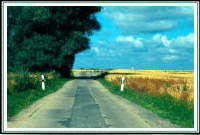 Although
the houses and buildings were all in fine shape, you could still
get the feeling that it had not changed that much in the
intervening 123 years. The map below shows the villages we were
able to visit in a one day tour of the area. Click on the names
to see details about each community. Although
the houses and buildings were all in fine shape, you could still
get the feeling that it had not changed that much in the
intervening 123 years. The map below shows the villages we were
able to visit in a one day tour of the area. Click on the names
to see details about each community.Things in this part of
Germany were already changing when August and family left but
you could still get a mental picture of how the community had
been in the 19th century. Unlike rural areas in the midwest were
individual farms with houses and barns lined up along rural
roads, the landscape was quite different in Mecklenburg.
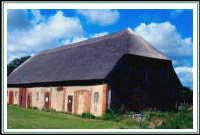 There
would be a small village spaced a few miles apart but few, if
any, farmsteads along the way. This area consisted of a large
estate owned by a noble or prominent family who lived in the
manner house. Farm laborers and house servants lived in the
small villages and made their way out to the farm to do their
work. There
would be a small village spaced a few miles apart but few, if
any, farmsteads along the way. This area consisted of a large
estate owned by a noble or prominent family who lived in the
manner house. Farm laborers and house servants lived in the
small villages and made their way out to the farm to do their
work.
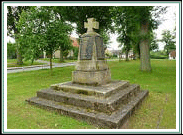 Gross
Wokern or Groß Wokern in German, was a small town which
today has around 1,100 residents. There is a central square in
the town that has a
World War I memorial and neat little houses on each side of
the road. There was the name of one Heiden on the plaque but we
have yet to discover a link to our Heidens. Gross
Wokern or Groß Wokern in German, was a small town which
today has around 1,100 residents. There is a central square in
the town that has a
World War I memorial and neat little houses on each side of
the road. There was the name of one Heiden on the plaque but we
have yet to discover a link to our Heidens.
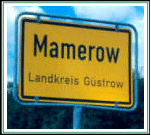 About
4 miles south of Gross Wokern is the village of
Mamerow which was where
August's future wife Elisabeth Sophia Wilhelmina Fredericka
Adolphine "Rika" Knaack or Knaack lived. You could imagine August
making the walk or getting a ride on a horse and buggy to court
his girlfriend in the next town. About
4 miles south of Gross Wokern is the village of
Mamerow which was where
August's future wife Elisabeth Sophia Wilhelmina Fredericka
Adolphine "Rika" Knaack or Knaack lived. You could imagine August
making the walk or getting a ride on a horse and buggy to court
his girlfriend in the next town.
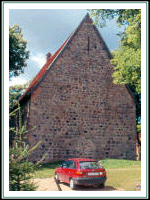
Several communities had old rock constructed churches with a
small graveyard. However, due to the long followed
burial customs of many
European countries, we did not find any Heiden gravestones. We
did find a few with names that are in the background of the
Heidens such as Laas and
Dreier but these were fairly recent additions to the
cemetery. Basically, due to the need for every piece of land,
graves are reused every few decades.
At the end of the day, we hoped back on the Autobahn and,
since we only had a small car, kept strictly to the right lane.
The big Mercedes and BMWs whizzed by us at over 100 miles per
hour on the no-speed-limit expressway.
 The
following day, we drove around Rostock, which has a population of around 16,000.
This town was significant in that it was the origin of a number
of letters sent to Rika (Knaack) Heiden in America in the 1920s after
August's death in 1922. From the return address on the letters,
we were able to find
18 Bramow Street which was the address found on several of
the letters. It was the home of August's half-sister's
granddaughter, Emilie Dahme. She was the daughter of
Marie
Rudolphine Johanne Auguste
Dohmstritch who was the
daughter of August's half-sister,
Friedericka Sophia Henrietta Johanna
Schmidt. The
following day, we drove around Rostock, which has a population of around 16,000.
This town was significant in that it was the origin of a number
of letters sent to Rika (Knaack) Heiden in America in the 1920s after
August's death in 1922. From the return address on the letters,
we were able to find
18 Bramow Street which was the address found on several of
the letters. It was the home of August's half-sister's
granddaughter, Emilie Dahme. She was the daughter of
Marie
Rudolphine Johanne Auguste
Dohmstritch who was the
daughter of August's half-sister,
Friedericka Sophia Henrietta Johanna
Schmidt.
Before heading back to the U.S. we wanted to visit Paris,
France. On the way, we took a slight detour to the Normandy
beaches, site of the D-Day invasion in 1944. In addition to the
heartbreaking and breathtaking cemetaries of the U.S. military,
there was a small German
cemetery nearby. We stopped there to see if we could find an
Heidens...and we did.
As mentioned above, click on the names of the individual
towns to see more details. |

